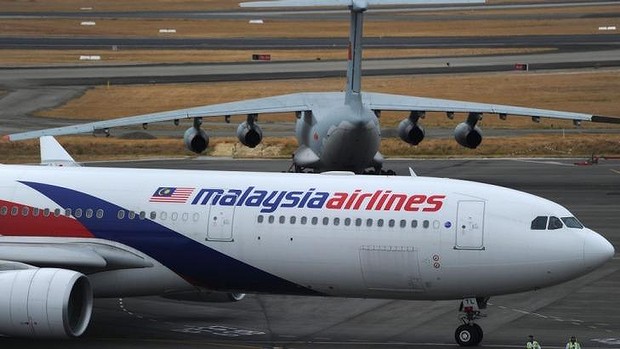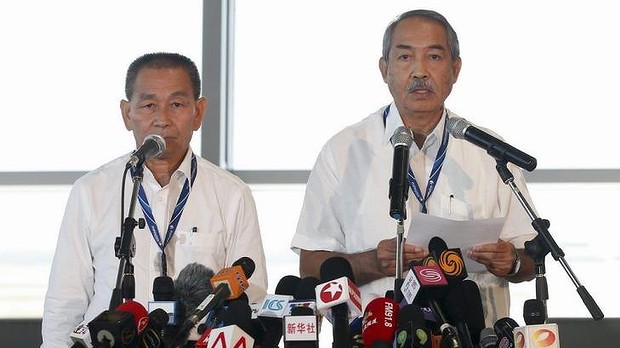
Mystery: A Malaysia Airlines plane prepares to go onto the runway and pass by a stationary Chinese Ilyushin 76 search aircraft (top) at Perth International Airport. Photo: AFP
Of all the various theories to have emerged about the disappearance of Malaysia Airlines flight MH370, this could be the most terrifying yet.
Aviation experts have raised the possibility that, if the flight’s pilots had become incapacitated, the passengers and cabin crew may have flown for seven hours aware that there was a problem but unable to raise the alarm .
That’s because the reinforced cockpit door, designed for maximum security, would have stopped staff or passengers from getting into the cockpit to make contact with the outside world.
No emergency communication system existed in the cabin of the plane, Fairfax Media has been told. Mobile phones may have been out of range, and the satellite phones which existed in business class could have been disabled, either purposefully or accidentally, by the same incident that eliminated the plane’s tracking systems.
‘‘There are no communications available from the cabin to the ground … only from the cockpit,” said Professor Jason Middleton, head of University of New South Wales School of Aviation.
Professor Middleton said post 9-11 security measures meant passengers and crew were isolated from the outside world if a plane’s pilots were out of action, whether by their own or someone else’s intention or through some sort of emergency.

Few clues to disaster: Malaysia Airlines Chief Executive Ahmad Jauhari Yahya (L) and Chairman of Malaysia Airlines Tan Sri Md. Nor Bin Md. Yusof speak to media. Photo: Reuters
‘‘It’s the modern world [that says] the only way to protect against illegal activities and hijacking is for the pilots to be safely ensconced so no one can get at them and no one can get at the systems.’’
Professor Middleton said the approach usually worked but that so far flight MH370 had proved to be an “unprecedented case”.
The flight path of the doomed Malaysia Airlines jet, established by British satellite company Inmarsat through the plane’s “ping” data, has shown that it flew for more than seven hours after it turned back from its scheduled flight path over the South China Sea on March 8.
Nobody yet knows why the plane deviated from its trajectory, or whether the pilots acted intentionally or were thwarted by some mechanical fault.
One theory already reported is that a catastrophic loss of pressure rendered all aboard unconscious, leaving the plane to fly on auto-pilot as a “ghost flight” until it crashed into the southern Indian Ocean.
But experts have confirmed that even if the passengers and cabin crew were okay, yet the pilots rendered incapacitated, there would have been little they could have done to alter their fate.
There is a precedent. In 2005 a Helios Airlines Boeing 737 was initially feared hijacked when it crashed into a mountain in Greece leaving 121 dead. A crash investigation revealed that the pilots had succumbed to hypoxia and had mistaken a pressure warning signal and lights for other safety alerts.
A flight attendant who had pilot training and was able to stay conscious tried unsuccessfully to control the plane before also passing out. The plane stayed in the air for two more hours before running out of fuel and crashing. Autopsies found that the passengers had been alive but could not establish whether they were conscious at the time of the crash.
An Australian commercial pilot, who did not want to be named, said flight MH370 would have had a reinforced cockpit door for security reasons. If the crew could not access the cockpit they would have been helpless without the pilots.
“There is no way they could raise the alarm,” he said.
But another commercial pilot, who also did not want to be named, said cabin crew flying with his airline were trained in a procedure that could allow them to access the cockpit if the pilots were incapacitated.
Fairfax is contacting Malaysia Airlines to check on the airline’s procedures.
American airline pilot and aviation author and blogger Patrick Smith also told Fairfax Media that if for any reason the pilots were unconscious or incommunicado, there would have been no way the for the crew to tell anyone.
There has been much speculation as to why no phone calls or messages were received from passengers or crew on the missing flight.
But Mr Smith said the lack of calls did not necessarily support the theory because unless a plane was flying low and within range of a mobile phone tower, mobile phones would not work.
Vincent Lau, an electronics professor specialising in wireless communications at Hong Kong University of Science and Technology, also told the New York Times that the altitude of the plane might have meant mobile phones could not connect with ground stations.
According to the Malaysia Airlines website, in-flight entertainment systems in business class on a Boeing 777-200, the model of flight MH370, are equipped with satellite phones.
Mr Smith said that this entertainment system could, however, be disabled as was the jet’s transponder and Aircraft Communications Addressing and Reporting System (ACARS). No one yet knows how and why these systems were not working.
Courtesy: www.smh.com.au

Leave a comment